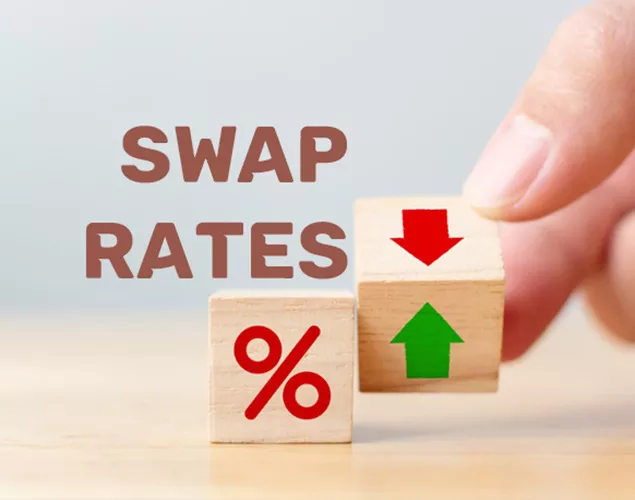The 5-year swap rate is a crucial financial indicator that reflects the fixed interest rate one party agrees to pay in exchange for receiving a floating rate over a five-year period. This rate serves as a benchmark for various financial instruments and provides insights into market expectations regarding future interest rates.
Introduction to Interest Rate Swaps
An interest rate swap is a financial derivative contract where two parties exchange future interest rate payments. Typically, one party pays a fixed rate, while the other pays a floating rate, with both rates applied to a notional principal amount. These swaps are primarily used to hedge against interest rate fluctuations or to speculate on changes in interest rates.
The Mechanics of a 5-Year Interest Rate Swap
In a 5-year interest rate swap, the agreement spans five years. One party agrees to pay a fixed interest rate annually or semi-annually, while receiving payments based on a floating rate, such as LIBOR (London Interbank Offered Rate) or SOFR (Secured Overnight Financing Rate), which resets periodically. The floating rate payments fluctuate with market conditions, whereas the fixed rate remains constant throughout the term of the swap.
Factors Influencing the 5-Year Swap Rate
Several factors influence the 5-year swap rate:
-
Monetary Policy Expectations: Anticipations regarding central bank actions, such as interest rate hikes or cuts, significantly impact swap rates.
-
Inflation Outlook: Expectations about future inflation influence the fixed rates set in swaps, as parties seek to maintain the real value of their payments.
-
Economic Growth Projections: Strong economic growth can lead to higher interest rates, affecting swap rates, while sluggish growth may have the opposite effect.
-
Supply and Demand Dynamics: The demand for fixed versus floating rate exposure can shift swap rates.
-
Credit Risk Perceptions: Changes in the perceived creditworthiness of counterparties can affect the terms of interest rate swaps.
Current 5-Year Swap Rates Across Different Markets
As of March 28, 2025, the 5-year swap rates in various markets are as follows:
-
United States: The 5-year USD interest rate swap was last recorded at 3.9725%, reflecting a slight decrease of 0.51% from the previous day.
-
India: The 5-year Overnight Indexed Swap (OIS) rate stood at approximately 5.90%, near its lowest since March 2022. This rate is influenced by expectations of aggressive rate cuts by the Reserve Bank of India in the fiscal year 2025-26.
-
China: The 5-year FR007 interest rate swap was recorded at 1.67% as of March 19, 2025.
-
United Kingdom: The 5-year SONIA swap rate was 3.94% as of March 20, 2025.
These variations highlight the impact of local economic conditions and monetary policies on swap rates.
The Significance of the 5-Year Swap Rate in Financial Markets
The 5-year swap rate serves as a critical benchmark in financial markets for several reasons:
-
Indicator of Market Expectations: It reflects market consensus on future interest rate movements and economic conditions.
-
Pricing of Financial Products: Many financial instruments, including certain types of bonds and derivatives, are priced based on swap rates.
-
Hedging Tool: Financial institutions and corporations use swaps to hedge against interest rate risks associated with their assets and liabilities.
-
Monetary Policy Transmission: Swap rates can signal the effectiveness of central bank policies in influencing market interest rates.
Applications of the 5-Year Swap Rate
The 5-year swap rate has various applications:
-
Hedging: Companies with floating-rate debt can use interest rate swaps to lock in fixed payments, thereby stabilizing future cash flows.
-
Speculation: Investors may speculate on future interest rate movements by entering into swaps, aiming to profit from anticipated changes.
-
Asset and Liability Management: Financial institutions manage the interest rate sensitivity of their balance sheets by using swaps to align the durations of assets and liabilities.
Risks Associated with Interest Rate Swaps
While interest rate swaps offer benefits, they also entail risks:
-
Counterparty Risk: The possibility that the other party may default on payment obligations.
-
Market Risk: Fluctuations in interest rates can lead to unfavorable changes in the value of swap positions.
-
Liquidity Risk: Difficulty in unwinding swap positions due to a lack of market participants.
-
Operational Risk: Challenges in managing complex swap agreements, including valuation and documentation errors.
Conclusion
The 5-year swap rate is a vital component of the financial landscape, offering insights into market expectations and serving as a critical benchmark for various financial instruments. Understanding its mechanics, the factors that influence it, and its applications can help investors and institutions navigate financial markets more effectively.
Related Topics:


